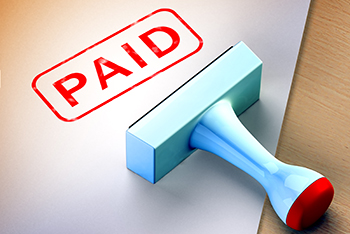 Feb. 3, 2016 – Your client may be eager to fight the case in court but completely unprepared for the struggle that happens after winning a favorable judgment. Even a simple and inexpensive small claims judgment might not do your client much good if the defendant is uncollectable. Your client is in for a shock if you wait until after the lawsuit is over before breaking the news that the judgment does not guaranty payment.
Feb. 3, 2016 – Your client may be eager to fight the case in court but completely unprepared for the struggle that happens after winning a favorable judgment. Even a simple and inexpensive small claims judgment might not do your client much good if the defendant is uncollectable. Your client is in for a shock if you wait until after the lawsuit is over before breaking the news that the judgment does not guaranty payment.
Before you begin preparing any litigation strategy, it is important to take a step back and examine your client’s goals. When your client is really looking for compensation, your case strategy should outline how you plan to recover what compensation and from whom. Often this involves delving into the world of post-judgment collections, a subject not typically covered in law school.
New lawyers who are faced with the task of helping clients recover compensation should take care to educate themselves in this area of law or consult with an experienced collections attorney.
Having the Collections Conversation
When discussing whether the fight is likely to be worthwhile or merely an exercise in throwing good money after bad, remember to include the following points:
1) Start with the law. It will give you a much better definition of what a judgment-proof person really is. Wisconsin protects certain personal property and income through its exemption statutes, most of which are found at Wis. Stat. section 815.18 (Property exempt from execution). However, do not focus on one obvious defendant so much that you overlook other sources of compensation. Could your client have a claim against other tortfeasors, insurers, businesses, partners, spouses, guarantors, or cosigners? Does your client have a security interest or a right to set off?
 Jennifer S. Limbach (U.W. 2014) is an attorney at Krekeler Strother S.C., Madison. Reach her by email or by phone at (608) 258-8299.
Jennifer S. Limbach (U.W. 2014) is an attorney at Krekeler Strother S.C., Madison. Reach her by email or by phone at (608) 258-8299.
2) Find out what your client knows. Your client may have an idea of some key facts, such as whether the defendant is employed, whether and where the defendant owns real property, and whether the defendant is the type of person to save or to care about credit scores. Ask your client for any financial information the defendant previously provided such as a financial disclosure or a credit application.
3) Do your own homework. Even if you do not use a commercial service such as skip tracing, take advantage of public sources of information to learn about the defendant. Circuit Court Access Program can tell you whether the defendant is obligated to pay child support, hence tying up much of their income available for garnishment. It can also help give you an indication as to whether the defendant is likely to settle, litigate, or simply default according the defendant’s “track record.” The Department of Financial Institutions records lien information and publishes this on its website. Social media websites, such as LinkedIn, may contain helpful business and personal information.
4) Consider the likely effects of your actions. If your client is seeking an amount that the defendant considers exorbitant, he or she may be driven to file bankruptcy and potentially discharge the entire debt. In situations where emotions run hot, filing suit without first making an effort to resolve the matter – ideally through the defendant’s more level-headed attorney – can also anger the defendant into fighting or filing bankruptcy rather than settling. Always talk to your client about the history of the relationship so that you can learn of any potential counterclaims the defendant might bring. Finally, make sure you educate yourself on fair debt collection laws so that your client’s actions – and your own – do not give rise to new counterclaims.
5) Prepare for the worst. Although you have up to 20 years to collect on your judgment, acting while your information about the defendant is fresh or while assets are still available can mean lower collection costs and more money for your client. Make sure that you are prepared to handle not just the suit itself, but also the post-judgment legal work. The work can vary from executing a simple wage garnishment to knowing when and how to take a lien on property by docketing judgments in multiple counties or even domesticating them in another state.
6) Determine how you are getting paid. Post-judgment collections are still subject to the American Rule, whereby everyone pays their own attorney’s fees unless a contract or statute provides a right to reimbursement. If your client does have a right to recover costs of collection, remember to assert it in the judgment. Failure to do so can terminate this right due to the merger doctrine, which stands for the premise that a contract merges with the final judgment.1 In either situation, you and your client need to agree on whether you will accept a portion of whatever you recover or bill hourly.
Hourly billing is advisable. You can easily spend many hours taking supplemental examinations, litigating garnishment objections, coordinating with out-of-state counsel, and chasing assets with little return if working on a contingent fee basis.
More than Just a Penny for your Thoughts
Simply pointing out the extent of the process can do wonders to cool down a heated client and manage your client’s expectations both for their situation and for you. Once you have advised your client of the various options and the potential consequences of each, your client may feel prepared to accept the risks of the matter.
Or your client may conclude that the risks of taking action outweigh the benefits. Ideally, however, you are providing your client not just a legal analysis of their claim, but also a valuable service that helps your client meet his or her goals.
This article originally appeared in the State Bar of Wisconsin Young Lawyers Division Newsletter, Fresh Perspectives (December 2015). It is republished here with permission.
Endnotes
1 See Production Credit Ass'n v. Laufenberg, 143 Wis.2d 200, 205, 420 N.W.2d 778 (Ct. App. 1988).
